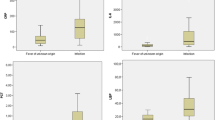Abstract
Objective
Cancer patients with febrile neutropenia after chemotherapy have a variable risk of bacterial infection. Especially Gram-negative bacteremia is associated with high mortality and/or morbidity. Early diagnosis of patients with Gram-negative bacteremia at the onset of febrile neutropenia is potentially useful in tailoring therapy.
Design and setting
Prospective study at the Department of Pediatric Oncology and Internal Medicine of a university hospital.
Patients
Were analyzed 66 febrile neutropenic episodes in 57 adults and children. Patients were divided into four groups: those with Gram-negative bacteremia, Gram-positive bacteremia, clinical sepsis, or fever of unknown origin.
Measurements and results
Plasma lipopolysaccharide-binding protein (LBP) and C-reactive protein (CRP) concentrations were determined. LBP at the onset of febrile neutropenia was significantly higher in patients with Gram-negative bacteremia than those with fever of unknown origin and those with Gram-positive bacteremia. Using a cutoff value for LBP proved to have much greater sensitivity, specificity, and positive and negative predictive value for Gram-negative bacteremia than the best cutoff value for CRP.
Conclusions
An initial high LBP level might predict Gram-negative bacteremia in cancer patients with febrile neutropenia. These results may have potential clinical impact by allowing therapy to be initiated for these patients at a very early stage.


Similar content being viewed by others
References
Bodey GP, Buckley M, Sathe YS (1966) Quantitative relationship between circulating leucocytes and infection in patients with acute leukemia. Ann Intern Med 64:328–340
Talcott JA, Finberg R, Mayer RJ, Goldman L (1988) The medical course of cancer patients with fever and neutropenia. Clinical identification of a low-risk subgroup at presentation. Arch Intern Med 148:2561–2568
Sickles EA, Greene WH, Wiernik PH (1975) Clinical presentation of infection in granulocytopenic patients. Arch Intern Med 135:715–719
Jack RS, Fan X, Bernheiden M, Rune G, Ehlers M, Weber A, Kirsch G, Mentel R, Furll B, Freudenberg M, Schmitz G, Stelter F, Schutt C (1997) Lipopolysaccharide-binding protein is required to combat a murine gram-negative bacterial infection. Nature 389:742–745
Faure E, Equils O, Sieling PA (2000) Bacterial lipopolysaccharide activates NF-kappaB through toll-like receptor 4 (TLR-4) in cultured human dermal endothelial cells. Differential expression of TLR-4 and TLR-2 in endothelial cells. J Biol Chem 275:11058–11063
Yang RB, Mark MR, Gray A, Huang A, Xie MH, Zhang M, Goddard A, Wood WI, Gurney AL, Godowski PJ (1998) Toll-like receptor-2 mediates lipopolysaccharide-induced cellular signalling. Nature 395:284–288
Vreugdenhil AC, Snoek AM, Van ‘t Veer C (2001) LPS-binding protein circulated in association with apoB-containing lipoproteins and enhances endotoxin-LDL/VLDL interaction. J Clin Invest 107:234
Martin TR, Rubenfeld GD, Ruzinski JT, Goodman RB, Steinberg KP, Leturcq DJ, Moriarty AM, Raghu G, Baughman RP, Hudson LD (1997) Relationship between soluble CD14, lipopolysaccharide binding protein, and the alveolar inflammatory response in patients with acute respiratory distress syndrome. Am J Respir Crit Care Med 155:937–944
Opal SM, Scannon PJ, Vincent JL, White M, Carroll SF, Palardy JE, Parejo NA, Pribble JP, Lemke JH (1999) Relationship between plasma levels of lipopolysaccharide (LPS) and LPS-binding protein in patients with severe sepsis and septic shock. J Infect Dis 180:1584–1589
Members of the American College of Chest Physicians/Society of Critical Care Medicine Consensus Conference Committee (1992) Definitions for sepsis and organ failure and guidelines for the use of innovative therapies in sepsis. Crit Care Med 20:864–874
Engel A, Mack E, Kern P, Kern WV (1998) An analysis of interleukin-8, interleukin-6 and C-reactive protein serum concentrations to predict fever, gram-negative bacteremia and complicated infection in neutropenic cancer patients. Infection 26:213–221
Bont ESJM de, Vellenga E, Swaanenburg JCJM, Kamps WA (2000) Procalcitonin: a diagnostic marker of bacterial infection in neutropenic cancer patients with fever? Infection 28:398–400
Svaldi M, Hirber J, Lanthaler AI, Mayr O, Faes S, Peer E, Mitterer M (2001) Procalcitonin-reduced sensitivity and specificity in heavily leucopenic and immunosuppressed patients. Br J Haematol 115:53–57
Bont ESJM de, Vellenga E, Swaanenburg JC, Fidler V, Visser-van Brummen PJ, Kamps WA (1999) Plasma IL-8 and IL-6 levels can be used to define a group with low risk of septicaemia among cancer patients with fever and neutropenia. Br J Haematol 107:375–380
Waage A, Remick D, Steinshamn S, DeForge L, Lamvik J (1994) Interleukin 8 in serum in granulocytopenic patients with infections. Br J Haematol 86:36–40
Freifeld A, Marchigiani D, Walsh T, Chanock S, Lewis L, Hiemenz J, Hiemenz S, Hicks JE, Gill V, Steinberg SM, Pizzo PA (1998) A double-blind comparison of empirical oral and intravenous antibiotic therapy for low-risk febrile patients with neutropenia during cancer chemotherapy. N Engl J Med 341:305–311
Pizzo PA (1993) Management of fever in patients with cancer and treatment-induced neutropenia. N Engl J Med 328:1323–1332
Author information
Authors and Affiliations
Corresponding author
Additional information
This study was supported by a grant from the University Hospital Groningen, The Netherlands
Rights and permissions
About this article
Cite this article
Oude Nijhuis, C.S.M., Vellenga, E., Daenen, S.M.G.J. et al. Lipopolysaccharide-binding protein: a possible diagnostic marker for Gram-negative bacteremia in neutropenic cancer patients. Intensive Care Med 29, 2157–2161 (2003). https://doi.org/10.1007/s00134-003-2026-2
Received:
Accepted:
Published:
Issue Date:
DOI: https://doi.org/10.1007/s00134-003-2026-2




